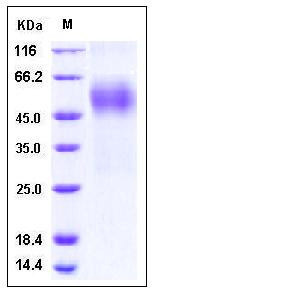Human OBCAM / OPCML Protein (His Tag)
IGLON1,OBCAM,OPCM
- 100ug (NPP2378) Please inquiry
| Catalog Number | P10328-H08H |
|---|---|
| Organism Species | Human |
| Host | Human Cells |
| Synonyms | IGLON1,OBCAM,OPCM |
| Molecular Weight | The mature recombinant human OPCML consists of 306 amino acids and has a calculated molecular mass of 34 kDa. As a result of glycosylation, rhOPCML migrates as an approximately 55-60 kDa protein in SDS-PAGE under reducing conditions. |
| predicted N | Gly 28 |
| SDS-PAGE |  |
| Purity | > 95 % as determined by SDS-PAGE |
| Protein Construction | A DNA sequence encoding the human OPCML precursor (NP_002536.1) (Met 1-Asn 322) was expressed with a C-terminal polyhistidine tag. |
| Bio-activity | |
| Research Area | Cancer |Signal transduction |G protein signaling |Small G proteins |Regulators of Small G proteins |
| Formulation | Lyophilized from sterile PBS, pH 7.4 1. Normally 5 % - 8 % trehalose, mannitol and 0.01% Tween80 are added as protectants before lyophilization. Specific concentrations are included in the hardcopy of COA. |
| Background | Opioid-binding Cell Adhesion Molecule (OBCAM), also known as OPCML, is a GPI-anchored cell adhesion molecule in the plasma membrane. This neuron-specific protein, consists of three immunoglobulin (Ig)-like domains anchored to the membrane through a glycosylphosphatidylinositol (GPI)-tail. OPCML also belongs to the member of the IgLON family, a subgroup of the immunoglobulin superfamily, consisting of three members, LAMP, OBCAM, and Neurotrimin. These molecules interact homophilically and heterophilically within the family, and OBCAM acts only as heterodimers with LAMP or Neurotrimin and possibly inhibits neurite outgrowth from cerebellar granule cells. OBCAM has been presumed to play a role as a cell adhesion/recognition molecule. Furthermore, the OPCML protein defects may play an important role in the carcinogenesis of cervical or ovarian cancers, and this gene is regarded as a candidate TSG (tumor suppressor gene). |
| Reference |
